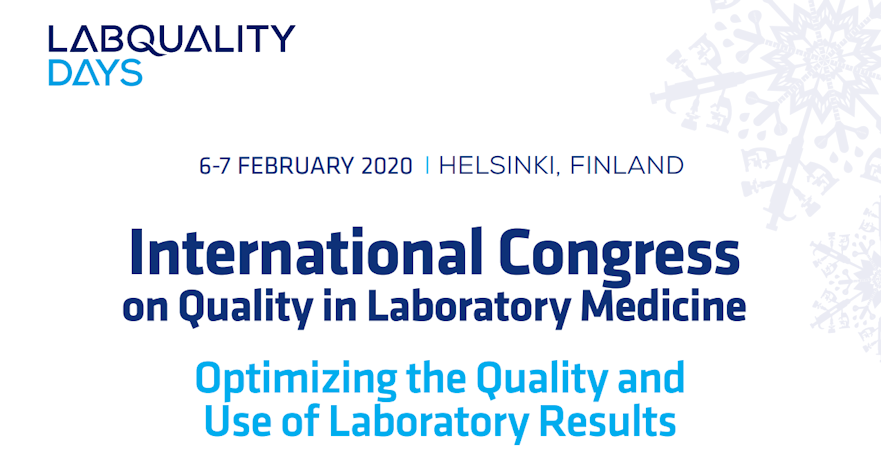How to ensure accurate and robust reference intervals?

Professor Yesim Özarda, from Uludag University gives an presentation about reference intervals on Thursday 6 February 2020 at the International Congress on Quality in Laboratory Medicine in Helsinki. Professor Özarda summarizes that the reference intervals are a vital part of the information supplied by laboratories to support the interpretation of numerical clinical pathology results. Reference intervals are most commonly defined as the central 95% of laboratory test results expected in a healthy reference population.
About the Speaker: MD, Ph.D.Yesim Özarda
 Yeşim Özarda graduated in 1990 from Istanbul University, School of Medicine, Istanbul, Turkey. She specialized in Biochemistry in 1996 at Marmara University School of Medicine, Department of Biochemistry, Istanbul. She has been working as a professor at the School of Medicine in the Department of Medical Biochemistry, Uludag University, Bursa, Turkey, since 2009. Her research areas include reference intervals and decision limits, biological variation, choline metabolism, adipokines and free fatty acids, genetic mutations in healthy Turks, quality control, accreditation and evidence-based laboratory medicine. Yeşim Özarda is a member of the International Federation of Clinical Chemistry (IFCC) Committee on Reference Intervals and Decision Limits (C-RIDL). She worked in the C-RIDL as a corresponding member during 2009-2011 and became a full member in 2011. She became the Chair of C-RIDL in 2016 and the work with C-RIDL is ongoing.
Yeşim Özarda graduated in 1990 from Istanbul University, School of Medicine, Istanbul, Turkey. She specialized in Biochemistry in 1996 at Marmara University School of Medicine, Department of Biochemistry, Istanbul. She has been working as a professor at the School of Medicine in the Department of Medical Biochemistry, Uludag University, Bursa, Turkey, since 2009. Her research areas include reference intervals and decision limits, biological variation, choline metabolism, adipokines and free fatty acids, genetic mutations in healthy Turks, quality control, accreditation and evidence-based laboratory medicine. Yeşim Özarda is a member of the International Federation of Clinical Chemistry (IFCC) Committee on Reference Intervals and Decision Limits (C-RIDL). She worked in the C-RIDL as a corresponding member during 2009-2011 and became a full member in 2011. She became the Chair of C-RIDL in 2016 and the work with C-RIDL is ongoing.
Abstract: Establishing and using reference intervals
In clinical laboratory medicine, patient test results are often interpreted by comparison to reference intervals (RIs), which are usually defined as the central 95% of laboratory test results obtained from a healthy reference population. The concept of reference intervals is now well established and the classical cascade is defined from reference individuals, a reference sample group, reference values, reference distribution, reference limits and RIs. The reference individuals form the reference sample group for measurement of the values from the reference population. Through statistical analysis of the distribution of the obtained values, the reference limits are calculated. These limits then define the RI. From 1987 to 1991, the International Federation of Clinical Chemistry (IFCC) published a series of 6 papers, in which it was recommended that each laboratory follow defined procedures to produce its own RIs. Although there were very important developments and implementations between the 1990s and 2008, the C28-A3 guideline, published in 2008 by CLSI and IFCC constituted the most significant step in the development of RIs and updated in 2010 as EP28-A3c guideline that is still in current use. entitled ‘Defining, Establishing, and Verifying Reference Intervals in the Clinical Laboratory’ provides the necessary steps mainly for the selection of reference individuals, pre-analytical and analytical considerations, analysis of reference values for a RI establishment study, transference and verification of the RIs. The recommended process for defining a reference interval is the so-called “direct” approach, where subjects representing the reference population are selected and sampled and the specimen analyzed for this purpose. Interest has been renewed in the topic as a result of the following regulatory initiatives in the last two decades: according to the European Directive 98/79 on in vitro diagnostic medical devices, diagnostic kit manufacturers are obliged to supply their clients with appropriate RIs for use with their assay platforms and reagents, and the International Organization for Standardization 15189 standard for clinical laboratory accreditation states that each laboratory should periodically re-evaluate its own RIs. In the present-day era of evidence-based medicine, there is still a big gap between theory and practice with respect to the application of RIs as decision-making tools, despite the mandatory requirements.
An alternative approach is the “indirect” approach where results from specimens are collected for routine purposes, which have been collected for screening, diagnostic or monitoring purposes and are used to determine the reference intervals. Last year, a review has been published in Clinical Chemistry and Laboratory Medicine by C-RIDL on the use of indirect approaches to establish and verify RIs from the results of routine laboratory testing. The indirect approach has some potential advantages/disadvantages compared with direct methods. The processes are faster, cheaper and do not involve patient inconvenience, discomfort or the risks associated with generating new patient health information. Indirect methods also use the same preanalytical and analytical techniques used for patient management and can provide very large numbers for assessment. However, limitations to the indirect methods include possible effects of diseased subpopulations on the derived interval. Currently, the Committee is working on the comparison of different statistical techniques for indirect methods to establish reference intervals with the existing direct methods.
Due to the increasing numbers of multi-centric studies in recent years, there was seen to be a need for a detailed protocol. IFCC, C-RIDL met this need with the publication of a very detailed protocol in 2014, which can be used when conducting multicentric studies. Based on this protocol a number of multicentric RI studies have been performed by the C-RIDL to establish RIs and to explore sources of variations on reference values across several countries and the results of the global study have been published in two articles in Clinica Chimica Acta that are accessible through the IFCC website. The common RIs reported in the multicenter study should be verified locally, using reference specimens from healthy individuals in the local population as recommended by EP28-A3c guideline. Additional verification procedures, including indirect methods, have become more widely used in challenging groups, such as children and the elderly, where sampling is difficult. recent years, as they are inexpensive and easy to perform.
It should be born in mind that instead of developing RIs directly from an apparently healthy population, most laboratories receive RIs for clinical use from various sources (e.g. manufacturers’ package inserts, publications, textbooks, multicenter studies, published national or international expert panel recommendations, guidelines, local expert groups or data mining of existing data). However, several differences can exist between the sample collection procedures and laboratory operations of the laboratory originated RI study and the local laboratory receiving the RI. Therefore, it is of critical importance for a local laboratory to address the following question prior to receiving RIs from an external source: “Is this RI suitable for my laboratory’s collection processes, method, and population?”. The CLSI guideline and literature encourage a method comparison study to transfer the same RI at a local or national level followed by verification of the transferred RI using samples from healthy individuals from the local population.
Labquality Days – International Congress on Quality in Laboratory Medicine
Welcome to the International Congress on Quality in Laboratory Medicine on 6-7 February 2020. The scientific program of the next International Congress on Quality in Laboratory Medicine will be built around the theme of optimizing quality. The program covers the topics on harmonization of medical practices, how to communicate the results to clinicians and patients and the quality assurance of new measurement technologies. Welcome to Helsinki!



